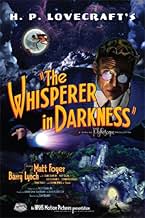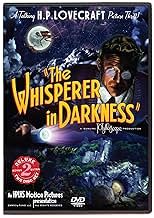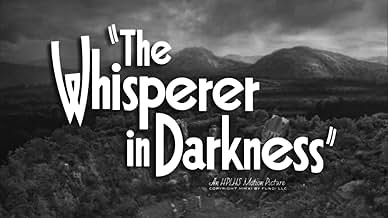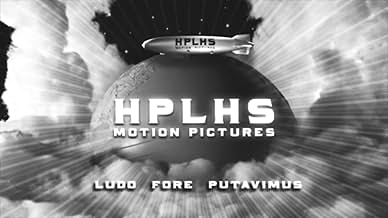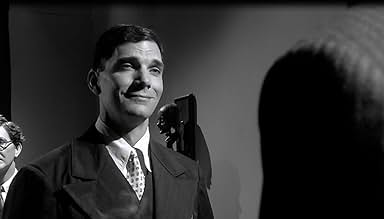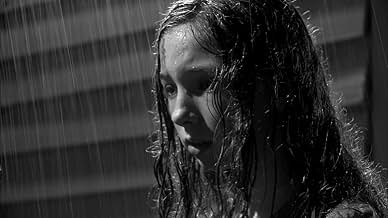VALUTAZIONE IMDb
6,5/10
3806
LA TUA VALUTAZIONE
Sulla base dell'H. P. Storia di Lovecraft con lo stesso nome, un folklorista indaga sui rapporti di creature insolite nel Vermont solo per scoprire più di quanto si aspettasse.Sulla base dell'H. P. Storia di Lovecraft con lo stesso nome, un folklorista indaga sui rapporti di creature insolite nel Vermont solo per scoprire più di quanto si aspettasse.Sulla base dell'H. P. Storia di Lovecraft con lo stesso nome, un folklorista indaga sui rapporti di creature insolite nel Vermont solo per scoprire più di quanto si aspettasse.
- Regia
- Sceneggiatura
- Star
- Premi
- 3 candidature totali
Conor Timmis
- Porter
- (scene tagliate)
Recensioni in evidenza
One cannot help but give full marks to the H.P. Lovecraft Historical Society for their efforts to bring H. P. Lovecraft's eerie stories to the screen in a manner in keeping with the texture and mood of the original material. Although there have been other attempts to film Lovecraft stories, most have generally been unsatisfying failures due to misguided attempts to modernize or glamorize them. Not so with HPLHS, who have gone out their way to keep faithful to the period and locales in which the tales were set, even going so far as give the film the feel of an early-1930s black-and-white movie. Even their logo is an homage to the the old Universal Studios logo of the early 1930s (the studio which produced such classic horror movies as Frankenstein, Dracula and The Mummy), replacing the familiar airplane-circling-the-earth with a dirigible.
The plot involves Albert Wilmarth, a college anthropology professor specializing in folklore, who becomes intrigued by a series of unusual newspaper stories reported from a rural part of Vermont after a period of particularly heavy rains. It seems that bodies have been observed washing down from the mountains in the swollen rivers, bodies which are, reportedly, neither human nor animal. The bodies apparently also recall, among the older inhabitants, old tales of strange beings that live in remote parts of the hills, beings that are neither human nor animal, and possibly not even of terrestrial origin. Wilmarth begins his investigation into these stories on the basis that they are nothing more than mere interesting folklore, but soon finds himself dealing with something far more sinister.
Admittedly, the producers of the movie added some material and characters not present in the original story. In fact, the short story actually ends at a point only about one hour into the film. However, the original version was, after all, only a short story, and I suppose the makers felt that they had to add some material to the plot in order to expand the short story into a full-length movie. nevertheless, the movie still does a far better job of evoking the feel of H.P. Lovecraft's writing than any other movie versions of his works, with the only possible exception being the resent silent film version of The Call of Cathulhu, which was made by the same producers.
One addition to the film is a debate staged between the protagonist, Professor Wilmarth, and Charles Fort. While that was not a part of H.P. Lovecraft's original story, it is interesting period touch because Charles Fort was actually a real person, a celebrated and controversial author of the early 1900s who was known to contemporaries as "The Mad Genius of the Bronx". Fort, who died in 1932, wrote about what are now called paranormal phenomena before that term was even invented, and is credited, among other things, with coining the word "teleportation".
The plot involves Albert Wilmarth, a college anthropology professor specializing in folklore, who becomes intrigued by a series of unusual newspaper stories reported from a rural part of Vermont after a period of particularly heavy rains. It seems that bodies have been observed washing down from the mountains in the swollen rivers, bodies which are, reportedly, neither human nor animal. The bodies apparently also recall, among the older inhabitants, old tales of strange beings that live in remote parts of the hills, beings that are neither human nor animal, and possibly not even of terrestrial origin. Wilmarth begins his investigation into these stories on the basis that they are nothing more than mere interesting folklore, but soon finds himself dealing with something far more sinister.
Admittedly, the producers of the movie added some material and characters not present in the original story. In fact, the short story actually ends at a point only about one hour into the film. However, the original version was, after all, only a short story, and I suppose the makers felt that they had to add some material to the plot in order to expand the short story into a full-length movie. nevertheless, the movie still does a far better job of evoking the feel of H.P. Lovecraft's writing than any other movie versions of his works, with the only possible exception being the resent silent film version of The Call of Cathulhu, which was made by the same producers.
One addition to the film is a debate staged between the protagonist, Professor Wilmarth, and Charles Fort. While that was not a part of H.P. Lovecraft's original story, it is interesting period touch because Charles Fort was actually a real person, a celebrated and controversial author of the early 1900s who was known to contemporaries as "The Mad Genius of the Bronx". Fort, who died in 1932, wrote about what are now called paranormal phenomena before that term was even invented, and is credited, among other things, with coining the word "teleportation".
In 1928, Miskatonic University folklore professor Albert Wilmarth enjoys debunking theories of the occult, even though he is roundly trounced – on radio, no less – by Charles Fort when they have a debate on whether certain stories in Vermont that have come to light following a flood are based in fact. He has also been carrying on correspondence with an intelligent, yet fearful, farmer in Vermont, who insists that the strange beings seen in the floodwaters are real, and are all around his farm. Wilmarth is curious, especially after he finds the original manuscript of a very rare book of folklore collected in Vermont back in the 1800s, containing stories which seem to correspond to what his farmer correspondent, Henry Akeley, has described in his letters. So when he receives a strange letter from Akeley that completely up-ends the farmer's previous fears about alien creatures and that invites Wilmarth to come to the farm to discuss the wondrous things that he has learned, well, Wilmarth can't possibly turn the invitation down. But when he arrives in the hills of Vermont, the local folk he meets all seem downright hostile, and when he arrives at the farm, he finds that Akeley himself is not well. And that is just the beginning of the discoveries that await him....
This film, created by a collective called the HP Lovecraft Historical Society, is clearly lovingly made – done in black and white and in the style of the early 1930s, it tells one of Lovecraft's more evocative tales and then expands upon it. (Lovecraft's story ends at about the one-hour mark of the film, which continues for another 40 minutes or so.) The atmosphere is terrific, and the style of the story-telling really permits the audience to feel themselves back in the early 1930s, even up to the various mad-scientist gadgets that evoke such classics as the lab in the original "Frankenstein" film. The monsters are more or less what one might expect to see in an early 1930s film based on an HP Lovecraft story, but that doesn't make them any less menacing or eerie. You don't need to be a Lovecraft fan to love this movie, though it wouldn't hurt; you probably don't even need to be a fan of old movies. You just have to love movies, especially ones with great atmosphere and straight-up acting and a storyline that keeps you involved every step of the way. Highly recommended!
This film, created by a collective called the HP Lovecraft Historical Society, is clearly lovingly made – done in black and white and in the style of the early 1930s, it tells one of Lovecraft's more evocative tales and then expands upon it. (Lovecraft's story ends at about the one-hour mark of the film, which continues for another 40 minutes or so.) The atmosphere is terrific, and the style of the story-telling really permits the audience to feel themselves back in the early 1930s, even up to the various mad-scientist gadgets that evoke such classics as the lab in the original "Frankenstein" film. The monsters are more or less what one might expect to see in an early 1930s film based on an HP Lovecraft story, but that doesn't make them any less menacing or eerie. You don't need to be a Lovecraft fan to love this movie, though it wouldn't hurt; you probably don't even need to be a fan of old movies. You just have to love movies, especially ones with great atmosphere and straight-up acting and a storyline that keeps you involved every step of the way. Highly recommended!
I am an avid fan of the writings of Lovecraft, well, and anything Lovecraftian in general, and happened to come across "The Whisperer in Darkness" by sheer luck. I didn't have my hopes up, because most previous movies based on Lovecraft stories had been off key or had too much focus on special effects and putting the ominous dread of the core of the story in the background.
However, as with the 2005 version of "The Call of Cthulhu", I was more than genuinely surprised in a good way with the 2011 film version of "The Whisperer in Darkness". This was right on the spot in every aspect; focusing on the storytelling, the build up of the cosmic dread and the despair of the protagonist.
The actors in the movie were doing good jobs bringing the story to life through their characters. And director Sean Branney really capture the essence of the timeless writing of Lovecraft.
However, personally, I am not overly keen on movies in black and white, as colors add so much more flavor to the movie experience. But keeping it in black and white works well enough for the movie, given the thematic setting of H.P. Lovecraft's mythos and universe.
"The Whisperer in Darkness" is a MUST watch for any fan of Lovecraft. And I rate it a solid seven out of ten stars. If the movie had been in color, the rating would have been eight. Visuals are important in the movie media.
However, as with the 2005 version of "The Call of Cthulhu", I was more than genuinely surprised in a good way with the 2011 film version of "The Whisperer in Darkness". This was right on the spot in every aspect; focusing on the storytelling, the build up of the cosmic dread and the despair of the protagonist.
The actors in the movie were doing good jobs bringing the story to life through their characters. And director Sean Branney really capture the essence of the timeless writing of Lovecraft.
However, personally, I am not overly keen on movies in black and white, as colors add so much more flavor to the movie experience. But keeping it in black and white works well enough for the movie, given the thematic setting of H.P. Lovecraft's mythos and universe.
"The Whisperer in Darkness" is a MUST watch for any fan of Lovecraft. And I rate it a solid seven out of ten stars. If the movie had been in color, the rating would have been eight. Visuals are important in the movie media.
I saw almost everything whats's been done in term of so called "Lovecraft Cinema". From '63 The Haunted Palace , through '85 Re-Animator and 2005 Call Of Cthulhu. This is by far one of the best Lovcraftian adaptations. It really holds the right spirit of both his books and early 50-ties sci-fi cinema. If you're looking for speedy CGI action - forget about this one. If you're into Edgar Allan Poe books, '31 Frankenstein or '56 Forbidden Planet and know at least who Lovecraft is you should definitely see this. Decent acting, good script filmed with the right pace and an old-school production. A perfect alternative for these days cinema. Highly recommended!
It is so hard to find a good Lovecraft movie. But this one is excellent. It does not rely on cheap jump scares or the like. It builds up a creepy atmosphere that scares you by suggesting the unimaginable otherworldly. Just like Lovecraft, it presents a vision of superior forces beyond the control of humanity. The acting is great and the screenplay is very fluid. The set design is amazing as well. Sadly, the digital effects are rather noticeable and cheap. Especially on the creatures. I would have really liked to see some good old stop motion, especially on a film that looks so eerily like an old 30s or 40s horror movie.
Lo sapevi?
- QuizCharles Fort (1874-1932) was a real person, a collector of accounts of unusual phenomena, disdaining scientists who would try to explain it all away, as seen in the film.
- BlooperWhen Professor Wilmarth is waiting for young Mr. Akeley at the Boston train station, Wilmarth turns his head to see that the train is approaching. Although the image is out of focus, it is clearly a modern train, not one that would be seen in the 1920's.
- Curiosità sui creditiAfter the FBI copyright warning: "all video involving fungal beings from the farther reaches of the solar system is carefully monitored by the Mi-Go, who deal harshly with those who duplicate and upload to the internet without permission."
I più visti
Accedi per valutare e creare un elenco di titoli salvati per ottenere consigli personalizzati
- How long is The Whisperer in Darkness?Powered by Alexa
Dettagli
- Data di uscita
- Paese di origine
- Sito ufficiale
- Lingua
- Celebre anche come
- 克蘇魯怪談:黑暗細語
- Aziende produttrici
- Vedi altri crediti dell’azienda su IMDbPro
- Tempo di esecuzione1 ora 43 minuti
- Colore
- Proporzioni
- 1.78 : 1
Contribuisci a questa pagina
Suggerisci una modifica o aggiungi i contenuti mancanti

Divario superiore
By what name was The Whisperer in Darkness (2011) officially released in India in English?
Rispondi

